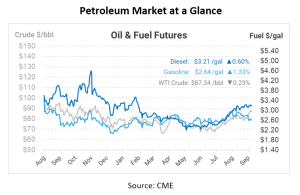
Hurricanes: How Storms Can Disrupt Fuel Supply Chain
The reliability of vehicles and equipment is essential for industries such as transportation, construction, aggregates, and more. When a natural disaster strikes, the local fuel supply can be severely hampered, putting operations at risk of grinding to a halt. This vulnerability necessitates proactive measures to brace for hurricanes before they make landfall. Analyzing the historical consequences of past storms, comprehending their trajectories, and understanding fuel behavior during crises can equip companies to tackle the impact of natural disasters on the fuel industry.
Lessons Learned
Drawing insights from previous supply disruptions is beneficial in responding effectively during hurricane seasons. Hurricanes Katrina, Rita, and Superstorm Sandy offer key lessons in this regard. Recently, Hurricane Idalia, which made landfall in Florida’s Big Bend as a category 3 storm – with winds over 100 mph — serves as a timely reminder of the ongoing threat posed by these natural disasters.
Hurricane Idalia: Hurricane Idalia reached the shores of Florida on August 30, 2023, prompting evacuations and safety measures across the region. Strong winds extending hundreds of miles from the storm’s center made fuel deliveries unsafe for days, delaying orders. With the 2023 Hurricane season ongoing, and weather authorities predicting further storms on the horizon, you must get ready now. You can learn more about the storm season and how to get prepared here.
Hurricane Katrina: Striking the United States in 2005, Katrina slashed Gulf Coast oil production by over 88%, shutting down nearly 10% of national refining capabilities. This caused fuel prices to surge overnight, with some areas witnessing $1/gallon increase, forcing retail stations to raise their prices.
Hurricane Rita: Following closely after Katrina, Rita devastated an industry still recovering from its predecessor’s impact. With around 5% of refining capabilities offline, Rita’s landfall further crippled refining operations by an additional 10%, delaying recovery.
Superstorm Sandy: In 2012, Superstorm Sandy highlighted the vulnerability of the East Coast. Refinery closures, pipeline shutdowns, and terminal destruction made fuel delivery nearly impossible. However, unlike Gulf storms, Sandy’s disruption led to decreased demand, offsetting inflationary pressures and gradually reducing retail prices.
Fuel Behavior during Hurricanes
Understanding how fuel behaves during hurricanes is crucial for disaster preparedness. As demand surges before a storm, fuel prices can spike. During the storm, overall demand decreases in the local area as people evacuate, though emergency services maintain a steady need. Recovery post-storm can be complicated by fuel infrastructure damage, affecting prices.
Governments play an essential role in mitigating the impact of hurricanes on fuel markets. They can release oil from strategic reserves, clear areas for critical infrastructure resumption, and waive regulatory constraints to ensure product availability and transportation.
Preparing for the Unpredictable
Natural disasters have historically wreaked havoc on the energy sector, resulting in significant economic losses. While the energy market takes a hit when storms strike the U.S., implementing well-informed strategies based on past disasters, understanding hurricane dynamics, and grasping fuel behavior can significantly reduce risks and facilitate swift recovery.
Mansfield Energy, North America’s leading fuel distributor, brings a wealth of expertise to the table in creating a robust emergency response program tailored to your company’s needs. Mansfield’s program offers a multi-tiered approach, prioritizing essential services and collaborating closely with partners to ensure seamless fuel distribution during emergencies. Contact us today!

This article is part of Daily Market News & Insights
Tagged:
MARKET CONDITION REPORT - DISCLAIMER
The information contained herein is derived from sources believed to be reliable; however, this information is not guaranteed as to its accuracy or completeness. Furthermore, no responsibility is assumed for use of this material and no express or implied warranties or guarantees are made. This material and any view or comment expressed herein are provided for informational purposes only and should not be construed in any way as an inducement or recommendation to buy or sell products, commodity futures or options contracts.





